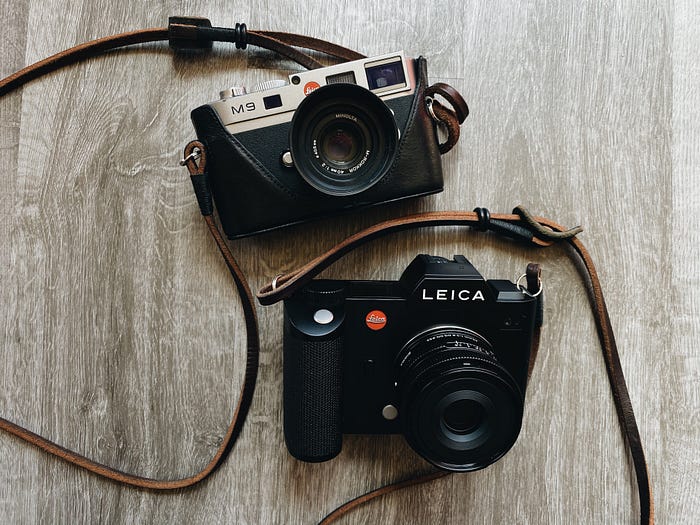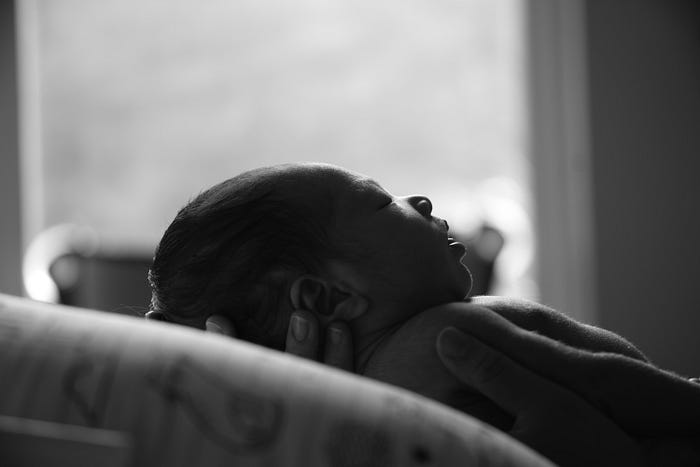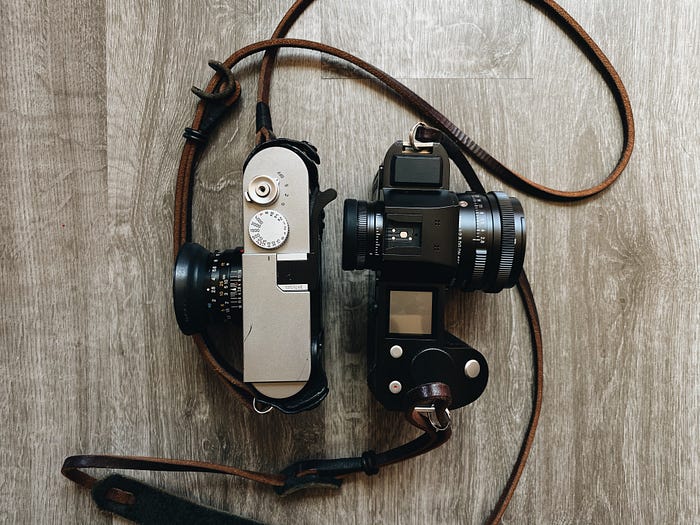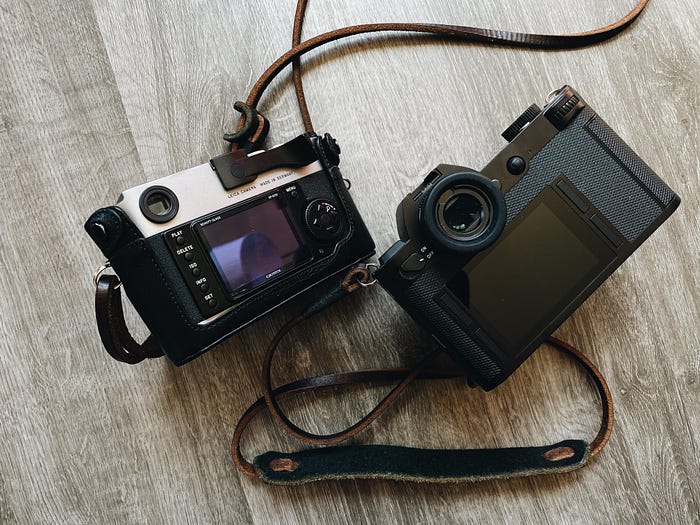JJ Casas
San Francisco-based portrait & commercial photographer &
creative director.
Sharing my thoughts as a photographer, cinematographer, marketer, and copywriter.
JCasas Photography | The Blog
© 2025 JJ Jumoc-Casas
jcasasphotography.com
A 2009 $6,000 camera and a 2015 $7450 camera: why I bought into Leica’s M9 & SL that I use today
Yes, these are the retail prices for two digital cameras: Leica’s M9 rangefinder and Leica’s SL mirrorless camera.

Why so expensive you may ask? Leica is essentially the Rolex of cameras. You may not own a Rolex watch but you for sure know that it’s expensive and recognizable. Rolex has its crown logo and Leica has its “red dot.” Leicas are surely priced high but the company does pride itself on the build quality, the materials used, and the hand craftsmanship it takes to build a camera like no other. However, if the camera specs are compared to its rivals (Sony, Canon, Nikon, etc), it’s a no-brainer that pound per pound Leica will lose.
Carey Rose of Dpreview said it best on her review of the SL:
"So far as I can tell, there just isn’t a strictly rational reason to recommend this camera to any particular type of photographer, but when has purchasing a Leica ever been a strictly rational decision?"
Those who buy into Leica don’t look at the spec sheet and immediately choose the one that’s better on paper. Same can be said who spends a lot on a Ferrari or on a Louis Vuitton bag — some buy it because of its heritage, some because of its exclusivity, while others buy it because they simply can.
So, why did you buy into these high priced cameras?
Here’s why (and how).
Let’s go over how I got them first as it’s more rational than “the why”; the short answer is: I bought the cameras used (it’s the only way I’d afford one).
I visit a forum frequently in which people sell and/or trade their gear and I got the seller to bring down his Leica M9 to $1800. This is where my rationale kicked in: “For $1800, this camera is ‘cheap’ considering it was $6000 in 2009!” Despite being a weak reason given the fact the camera is 10 years old, for me this was good enough to buy it.
Same for the Leica SL — was bought in the same forum but for $2200 when it had retailed for $7450 in 2015.
I’ve owned and used cameras from almost all manufacturers but I’d bet that no one would want to buy a decades-old digital camera from the like and use it today. I knowingly bought old tech by purchasing a nearly decades old digital camera when I got the Leica M9 in June 2018 and the five-year old SL this year. Leica’s allure is real (just like many luxury goods) but I do know that most people who buy one simply want to use it. You may buy something vintage for nostalgia’s sake but you typically would keep it pristine on a shelf or include it as part of your collection. I would believe that most people who get a Leica want to use it.
And now onto my “why”.
I’ll answer the most obvious but rational questions:
Why pay premium dollar for a digital camera that isn’t up to par to what’s available in the current market?
The value sometimes isn’t what it’s capable of doing but how it enables you to do something. Leicas are usually out of date to begin with — there’s a camera that’s always going to be better in terms of specs. When I wrote why it matters what camera you use, it’s a feeling sometimes that a camera can give you to shoot more and aspire you to be better. Think about an object that you prize and what it means to you. Whether it’s bought, inherited or made, there’s something about that object that triggers something you can’t get from anything else.
Why spend so much on a camera (body) especially when a new model is bound to be released?
TLDR: these cameras will cure my GAS for a long time to come.
Photographers have this thing called G.A.S. — Gear Acquisition Syndrome. We’re always looking for the next best thing despite having super adequate equipment that will work fine for years to come. Especially in today’s world where we upload a lot on our phone and view it from there, having the absolute best or high resolution for example is really not warranted. As a professional, having the right gear will help you perform at your very best but truth be told, I didn’t buy a Leica thinking I’ll be using it on a paid professional shoot. Instead, I bought it knowing I’ll be using it for personal use. The image processor in these particular cameras and lens combinations has a certain aesthetic that enables me to spend less time editing and just getting it right in-camera. For me, it’s a personal camera’s dream.
Why would you use a camera that’s valued so high?
No one buys a Rolex, Ferrari or Louis Vuitton bag to not be seen with it. It’s a social flex and I happily contribute it. :) But really, carrying a Leica has also been an easy conversation piece. Anyone who’s into photography knows of Leica and is typically curious on how it handles and performs in real life. I’ve had spontaneous conversations with people who recognize the camera on my shoulder and delve in photography for a bit.
Why did you buy this when you’re about to be a father?
With the birth of our daughter Kiran Rey on May 3rd (you’ll see some photos from the M9 in the linked video), being a father has really slowed me down (in a good way.. unlike the pandemic’s shelter in place which has affected many of us to work). With the time I do have with her when she’s awake, I 100% prefer taking photos with my Leica over my iPhone. Yes, you can use any other camera brand and yes, it is easier to take and share photos from the phone. However, there’s something more satisfying taking these photos with a camera that requires your ability to operate it and its exclusivity that the photos you take with it are truly personal, Plus, it won’t get lost in your phone’s camera roll.

So, which camera is better in today’s use?
Here’s a quick summary of the two (full comparison here)
Leica M9 (September 2009)
- Resolution: 18mp
- Body: Rangefinder
- Viewfinder: Optical (rangefinder)
- Sensor: Full frame with CCD sensor
- Focus points: 0 (manual focus only)
- Lens mount: M-mount
- Continuous drive: 2fps
- ISO: 80–2500
- Screen size: 2.5"
Leica SL (October 2015)
- Resolution: 24mp
- Body: Large SLR
- Viewfinder: EVF (electronic viewfinder)
- Sensor: Full frame with CMOS sensor
- Focus points: 529
- Lens mount: L-mount
- Continuous Drive: 11fps
- ISO: 50–50000
- Screen size: 3" screen
Here’s the thing: I actually enjoy using the decade old M9 more than the SL despite the SL having more modern features that are more up to par to today’s mirrorless cameras.

To begin with, the M9 is a rangefinder which does not reflect what or how exactly the final image will look like. Being able to see my environment and subject as-is without technical data overlays allows me to still be present. Yes, I’m still putting up a camera to my eye and in between my subject but what I’m seeing is still what my normal eye would see — not what the sensors sees (EVF aka electronic viewfinders) or what the lens sees (traditional SLR/DSLRs).
Regarding autofocus, of course it’s helpful in a myriad of ways in various settings. But when you have time and are focusing purposely without the assistance of a computer chip, nailing a shot and even deciding to on your own is more satisfying. It’s the same difference of buying a cake for a loved one versus making it yourself.
Yes, the M9’s screen resolution is crap compared to today’s high resolution ones but for a Leica (arguably photography in general), it was never suppose to be about chimping (take a photo and immediately look at the back of the camera and zoom in 100% to see if it was focused and exposed). With a manual camera, it forces you to ensure you know your basics of photography (with a rangefinder knowing your depth of field with apertures is highly recommended) and reflexes on both focusing and anticipating the shot.
The SL is more in line of what I’ve shot with more recently notably the A7III. It has all the bells of whistles of a full frame mirrorless camera (high frame rate, really fast autofocus and ability to record 4K video). For me, there’s two features that I like the SL over the M9. One, it’s a goddamn nice camera nearing 2 lbs. and to hold and use it reminds you that it’s camera first that happens to have digital innards. Hard to explain that feeling but I guarantee you’ll have a different feeling using this camera versus Sony’s latest mirrorless camera. And secondly, the image sensor on the SL is better allowing you to shoot cleaner images especially in low light. That’s a given since its sensor is newer.

So, should I buy a Leica?
I mentioned earlier who would buy into Leica and they are:
Someone who buys it because of its heritage
If you have an appreciate for photography and what values Leica can bring to your table, get it.
Someone who buys it because of its exclusivity
Buying something to set yourself apart is really not a good reason. Yet, it drives us to buy a lot of things. So, get it.
Someone who buys it because they simply can
This expense will never be an investment unless you’re collecting super rare cameras and lenses. But if you’re able to make money using it for a paid job, then by all means justify the purchase and get it.
Optics are sometimes everything in the photography industry. I’ll share how I was chosen to shoot a campaign based off of a camera I own and use on another post. :)